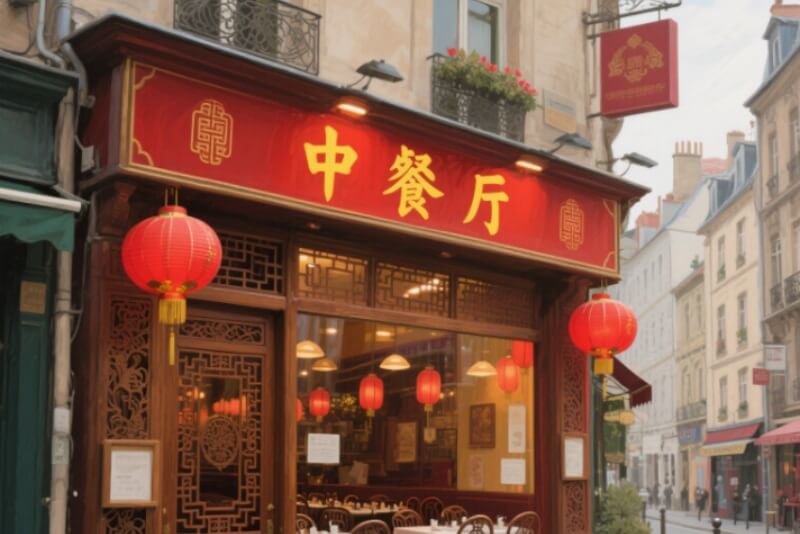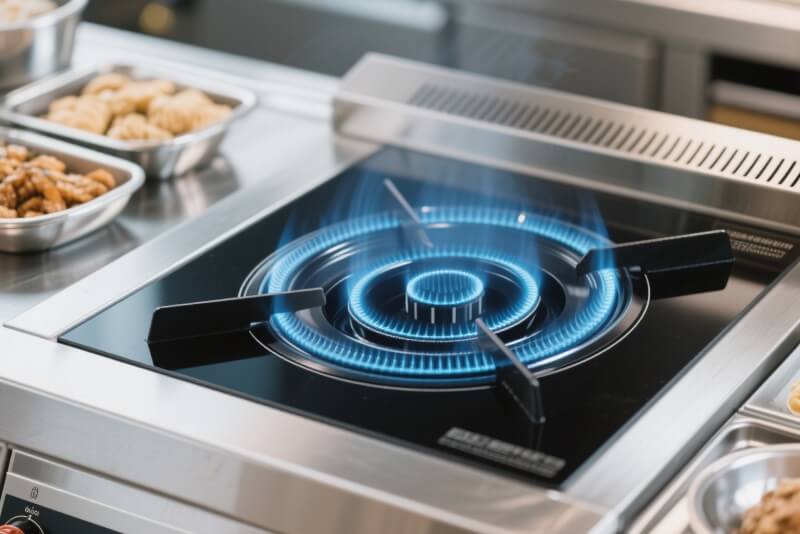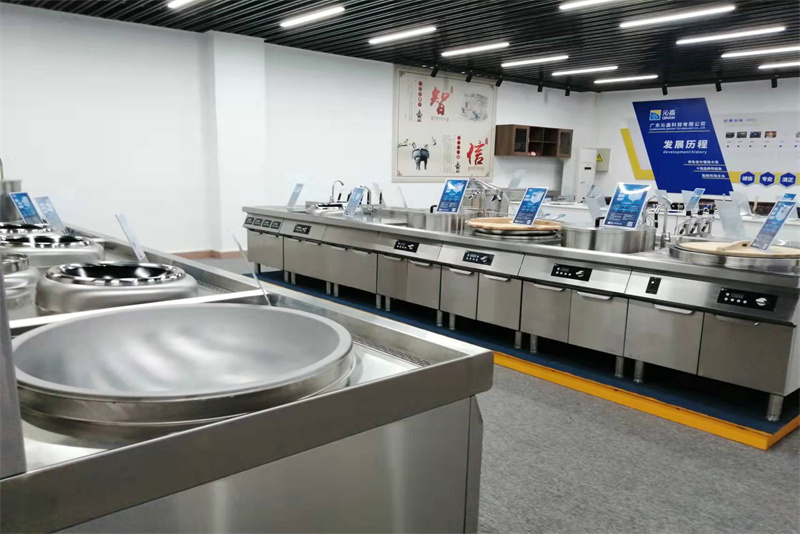Opening a Chinese restaurant in Europe presents many opportunities and challenges. To run the restaurant…
.jpg)
Commercial Induction Kitchen: Future Trends in Efficiency, Energy Saving, and Safety
In today’s increasingly competitive catering industry, the choice of commercial kitchen equipment is not only about cooking efficiency but also directly affects operating costs, food safety, and environmental compliance. From traditional gas stoves to intelligent induction cooking equipment, commercial kitchens are undergoing a profound change.
This article will explore improving kitchen efficiency, reducing energy consumption, ensuring food safety, and following environmental protection trends by choosing suitable commercial cooking equipment to inject sustainable competitiveness into your catering business.
I. Pain points and challenges in the catering industry
With the upgrading of consumption and the continuous rise in labor costs, catering companies are facing unprecedented pressure. Inefficient kitchens, serious energy waste, frequent food safety hazards, and increasingly stringent environmental regulations have become the four major problems that plague catering practitioners.
1. High labor costs
According to industry statistics, the labor costs of catering companies have accounted for 30%-40% of the total operating costs and are showing an upward trend year by year. The high-intensity work and skill dependence of kitchen staff have made recruitment and training costs high. At the same time, young people’s interest in traditional kitchen work has gradually decreased, resulting in the industry generally facing the dilemma of “difficulty in recruiting workers.”
2. Energy waste and cost pressure
The thermal efficiency of traditional gas stoves is usually only 30%-40%, and a large amount of heat is lost to the air, which not only wastes energy but also increases the burden on kitchen air conditioning. For example, for a medium-sized restaurant, the monthly gas bill may be as high as tens of thousands of yuan, and the low energy utilization rate directly erodes the profit margin.
3. Food safety and sanitation hazards
The standardization of kitchen operations is low, and food safety problems caused by human factors occur frequently. For example, improper oil temperature control, inconsistent cooking time of ingredients, and inadequate cleaning of equipment may cause food safety accidents, causing huge reputation and economic losses to the company.
4. Strict requirements of environmental protection regulations
Many places have issued environmental protection regulations for catering companies, requiring the reduction of oil fume emissions and noise pollution and the gradual elimination of high-energy consumption equipment. Traditional kitchen equipment makes it difficult to meet these requirements, and companies may face the risk of high fines or even suspension of business.
II. The rise of intelligent commercial cooking equipment
In the face of the above challenges, intelligent commercial cooking equipment came into being. Through technological innovation, this type of equipment not only improves cooking efficiency but also achieves energy conservation and consumption reduction, food safety, and environmental compliance, making it an ideal choice for catering companies.
1. High efficiency and energy saving: the advantages of induction cookers and embedded induction cookers
As a new generation of cooking equipment, induction cookers and embedded induction cookers have a thermal efficiency of more than 90%, far exceeding traditional gas stoves. Fast heating speed and precise temperature control can significantly shorten cooking time and improve meal delivery efficiency. For example, the time to boil a pot of water can be shortened from 10 minutes on a traditional gas stove to 3-5 minutes, greatly improving the speed of back kitchen operations.
At the same time, the energy-saving effect of induction cookers is significant. Taking a Chinese restaurant that cooks 200 dishes a day as an example, using an induction cooker can save 30%-50% of energy costs per month compared to a traditional gas stove. In addition, the induction cooker has a no-open-flame design, which avoids gas leakage and fire risks, providing additional protection for kitchen safety.
2. Automated cooking: the revolutionary application of automatische kookmachines and griddles
The emergence of automatic cooking machines and griddles completely changed the traditional mode. The automatic cooking machine can achieve precise temperature control, automatic stir-frying, and timed cooking through preset programs to ensure that the taste of each dish is stable and consistent. Whether it is the spicy and fresh Sichuan cuisine or the fresh and tender Cantonese cuisine, it can be easily mastered.
The griddle has become a must-have equipment for Western-style fast food and Japanese restaurants with its uniform heating and efficient cooking characteristics. Its surface temperature is evenly distributed, it can cook a variety of ingredients at the same time, and it is easy to clean and maintain. For chain catering companies, this automated equipment can effectively reduce dependence on chef skills, reduce labor costs, and improve meal efficiency and food quality.
3. Food safety and hygiene: Innovative design of rice steaming cabinets and clay pot stoves
Rice steaming cabinets and clay pot stoves perform well in food safety and hygiene. The rice steaming cabinet uses steam heating to avoid open flames and oil smoke, reduce the contact between ingredients and air, and thus reduce the risk of bacterial growth. Its inner tank is usually made of food-grade stainless steel, which is easy to clean and meets HACCP food safety management standards.
The clay pot stove ensures a stable and reliable cooking process of clay pot rice through a precise temperature control system. Its uniform heating avoids the problem of partial overcooking or undercooking of ingredients while reducing the generation of oil smoke and creating a cleaner working environment in the kitchen. For companies that focus on food safety, these devices are undoubtedly an ideal choice.
4. Environmental protection and compliance: Green solutions for deep fryers and noodle cookers
Fryers and noodle cookers are particularly outstanding in terms of environmental protection. Modern deep fryers use high-efficiency filtration systems to significantly reduce oil smoke emissions and comply with local environmental protection regulations. Its intelligent temperature control system can avoid oil oxidation and harmful substances caused by excessive oil temperature, extend the service life of cooking oil, reduce the frequency of replacement, and thus save costs.
The noodle cooker achieves high efficiency and energy saving in the noodle cooking process through precise water temperature control and rapid heating technology. Its closed design reduces heat loss while reducing kitchen humidity and improving the working environment. For catering companies that pursue environmental protection and energy saving, these devices are undoubtedly an important step towards a green kitchen.
-
 Tabletop Automatic Wok Cooking Machine for Restaurant Kitchen LT-CD300T-C205
Tabletop Automatic Wok Cooking Machine for Restaurant Kitchen LT-CD300T-C205 -
 Tabletop Automatic Stir-frying Wok Machine for Restaurant LT-CD300T-C105
Tabletop Automatic Stir-frying Wok Machine for Restaurant LT-CD300T-C105 -
 Industrial Automatic Wok Cooking Machine Stir-Fryer LT-CD700T4-D130
Industrial Automatic Wok Cooking Machine Stir-Fryer LT-CD700T4-D130 -
 Automatic Robotic Wok Cooking Machine for Restaurant Canteen LT-CD300L-A205
Automatic Robotic Wok Cooking Machine for Restaurant Canteen LT-CD300L-A205 -
 Countertop Commercial Gas Automatic Fried Rice Machine LT-TGD36R
Countertop Commercial Gas Automatic Fried Rice Machine LT-TGD36R -
 Automatic Cooking 6 Burners Commercial Induction Cooker LT-B300VI-E235
Automatic Cooking 6 Burners Commercial Induction Cooker LT-B300VI-E235 -
 LT-CJ550-D208 Ming Stall Commerciële Automatische Roerbak Wok Machine
LT-CJ550-D208 Ming Stall Commerciële Automatische Roerbak Wok Machine -
 Industriële Elektrische Automatische Roerstoof Wok LT-XC80
Industriële Elektrische Automatische Roerstoof Wok LT-XC80 -
 Zware automatische roerbak-kookrobot LT-GD36/9
Zware automatische roerbak-kookrobot LT-GD36/9
III. Selection Guide for Commercial Cooking Equipment
To choose the right commercial cooking equipment, you need to consider the size of the kitchen, the type of dishes, the budget, and future expansion needs. Here are some key selection suggestions:
1. Choose equipment capacity according to the size of the kitchen
Small restaurants or cafes can choose single-head induction cookers, small rice steamers, and mini fryers to meet daily needs and save space. Medium and large restaurants need to be equipped with multi-head induction cookers, large rice steamers, and high-efficiency griddles to cope with high-load operations during peak hours.
2. Matching dish types with equipment functions
Sichuan restaurants can focus on automatic cooking machines and high-power induction cookers to meet the needs of stir-frying and high-temperature cooking; Cantonese restaurants are suitable for clay pot stoves and noodle cookers to ensure the quality of clay pot rice and soup noodles; Western restaurants can give priority to griddles and embedded induction cookers to improve the cooking efficiency of steaks and pasta.
3. Consider budget and long-term costs
Although the initial investment in intelligent equipment is high, its energy-saving effect and service life can significantly reduce long-term operating costs. For example, the service life of an induction cooker can usually reach 8-10 years, while traditional gas stoves are only 5-7 years. From the perspective of the whole life cycle cost, intelligent equipment is more economical.
4. Reserve expansion interface and intelligent upgrade space
Choosing equipment that supports IoT functions can realize remote monitoring and data analysis, laying the foundation for the intelligent upgrade of the kitchen in the future. For example, through the intelligent system, the operating status of the equipment can be monitored in real-time, faults can be warned, downtime can be reduced, and overall operational efficiency can be improved.
IV. Future trends of intelligent kitchens
With the continuous development of artificial intelligence, IoT, and big data technologies, commercial kitchens are moving toward comprehensive intelligence. The kitchen of the future will have the following characteristics:
1. Fully automated cooking process
From food preparation to finished product delivery, the entire cooking process will be automated. Intelligent equipment can automatically adjust cooking parameters according to preset menus, reduce human intervention, and further improve the efficiency and consistency of dishes.
2. Energy management and carbon neutrality
Intelligent kitchens will be equipped with energy management systems to monitor equipment energy consumption in real time and optimize usage strategies. Combined with the application of renewable energy, such as solar energy and wind energy, catering companies are expected to achieve carbon neutrality goals and enhance their corporate social responsibility image.
3. Food safety traceability and intelligent monitoring
Through the Internet of Things technology, kitchen equipment can be seamlessly connected with the food safety management system to achieve full traceability of food sources, cooking processes, and finished product quality. The intelligent monitoring system can warn of food safety risks in real time to ensure the safety and reliability of each dish.
4. Personalized customization and flexible production
With the diversification of consumer demand, intelligent kitchens will support personalized, customized production. The equipment can adjust cooking parameters in real-time according to orders to meet the taste preferences of different consumers and provide differentiated competitive advantages for catering companies.
V. Conclusion: Embrace intelligence and open a new era of kitchens
Today, as the catering industry accelerates its transformation, intelligent commercial cooking equipment has become the key to improving competitiveness. From induction cookers and automatic cooking machines to rice steamers and fryers, these devices not only solve the core issues of efficiency, energy saving, safety, and environmental protection but also open the door to the kitchen of the future for enterprises.
As a manufacturer of commercial cooking equipment, we are committed to providing you with a full range of intelligent kitchen solutions. Whether you are building a new restaurant or upgrading your current one, we will tailor the equipment selection plan according to your specific needs and provide comprehensive after-sales service to ensure that your kitchen operates efficiently and is continuously profitable.
Choosing commercial induction cooking equipment is a response to current challenges and an embrace of future trends. Let us work together to create a new era of intelligent kitchens and inject endless power into your catering business!
automatische kookmachine automatische kookmachines bbq chip fryer commercial cooking equipment commercial drop in induction cooker commercial food steamer commercial induction cooker commercial induction cooktop commerciële inductiefriteuse commercial induction fryer commerciële inductieplaat commercial induction soup cooker Commerciële inductiestoomkoker commerciële inductiewokplaat commerciële keuken cookware food steamer hob induction cooker induction cookware INDUCTION FRYER induction grill induction hob iron wok kitchen equipment repair guide restaurangt equipment restaurant equipment stainless steel cookware user's guidance



Dit bericht heeft 0 reacties